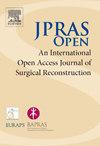Outcomes of temporalis muscle-based facial reanimation surgery: A systematic review and meta-analysis
IF 1.5
Q3 SURGERY
引用次数: 0
Abstract
Background
Despite the encouraging findings of temporalis muscle-based facial reanimation surgery without the need for nerve grafting, there is a need for comprehensive evaluation of the impact of temporalis-based facial reanimation surgery on key outcome measures.
Methods
Comprehensive search in Medline and Embase databases were carried out up to 25 February 2023. The articles that examined facial reanimation surgery using the temporalis muscle were included in this study. Postoperative changes in smile excursion and the angle of the mouth while smiling were pooled using the DerSimonian and Laird random-effects model. Narrative synthesis was conducted for other outcomes including assessments of spontaneous smile, subjective evaluation of facial symmetry using validated rating tools, functional outcomes, aesthetic outcomes and patient-reported outcomes owing to heterogeneity in reporting of the outcomes.
Results
Twenty-four studies were included in the analysis. Conflicting evidence was demonstrated regarding emotional smile outcomes and its definition. The pooled changes in smile excursion postsurgery were 7.06 mm (95% CI: 3.73-10.40, P < 0.001; I2 = 0%) and the angle of the mouth were 11.76° (95% CI: 8.80-14.71, P < 0.001; I2 = 0%). Significant improvement was reported across the validated rating scales of symmetry, functional outcomes, aesthetic outcomes and patient-reported outcomes whereas the superiority compared to other procedures remained inconclusive.
Conclusion
Overall, temporalis-based facial reanimation surgery is a promising option for addressing the negative effects of facial nerve paralysis on the patients’ quality of life. This study highlights the uncertainty surrounding the technique and need for further studies.
颞肌面部再生手术的结果:系统回顾和荟萃分析。
背景:尽管基于颞肌的面部再生手术在不需要神经移植的情况下取得了令人鼓舞的结果,但仍有必要对基于颞肌的面部再生手术对关键结果指标的影响进行全面评估。方法:综合检索截至2023年2月25日的Medline和Embase数据库。研究使用颞肌进行面部再生手术的文章被纳入本研究。使用DerSimonian和Laird随机效应模型汇总术后微笑偏移和嘴角角度的变化。对其他结果进行叙述性综合,包括自发微笑的评估,使用经过验证的评分工具对面部对称性的主观评估,功能结果,美学结果和患者报告的结果(由于结果报告的异质性)。结果:24项研究被纳入分析。关于情绪微笑的结果及其定义,有相互矛盾的证据。术后微笑偏移的总变化为7.06 mm (95% CI: 3.73 ~ 10.40, P < 0.001;I2 = 0%),口腔角度为11.76°(95% CI: 8.80 ~ 14.71, P < 0.001;I2 = 0%)。在对称性、功能结果、美学结果和患者报告结果的有效评定量表上报告了显著的改善,而与其他程序相比的优越性仍不确定。结论:总的来说,基于颞部的面部再生手术是解决面神经麻痹对患者生活质量的负面影响的一个有希望的选择。这项研究强调了围绕该技术的不确定性和进一步研究的必要性。
本文章由计算机程序翻译,如有差异,请以英文原文为准。
求助全文
约1分钟内获得全文
求助全文
来源期刊

JPRAS Open
Medicine-Surgery
CiteScore
1.60
自引率
0.00%
发文量
89
审稿时长
22 weeks
期刊介绍:
JPRAS Open is an international, open access journal dedicated to publishing case reports, short communications, and full-length articles. JPRAS Open will provide the most current source of information and references in plastic, reconstructive & aesthetic surgery. The Journal is based on the continued need to improve surgical care by providing highlights in general reconstructive surgery; cleft lip, palate and craniofacial surgery; head and neck surgery; skin cancer; breast surgery; hand surgery; lower limb trauma; burns; and aesthetic surgery. The Journal will provide authors with fast publication times.
 求助内容:
求助内容: 应助结果提醒方式:
应助结果提醒方式:


